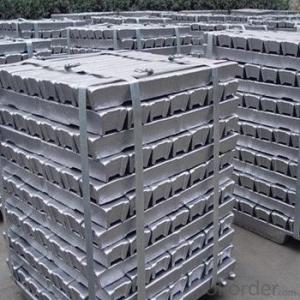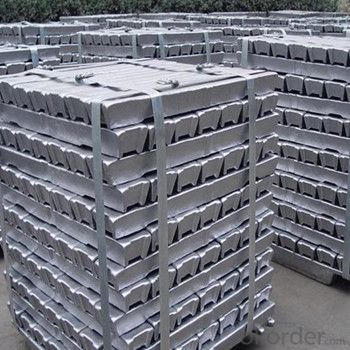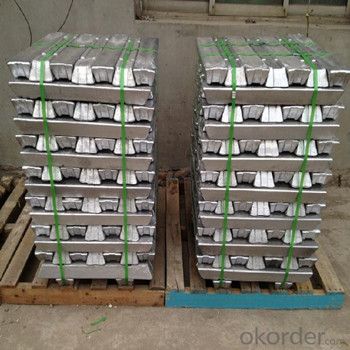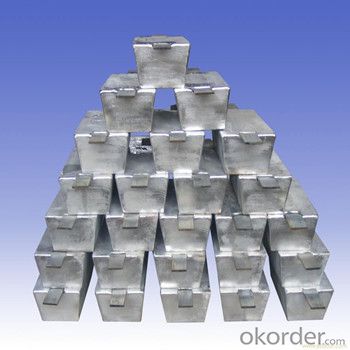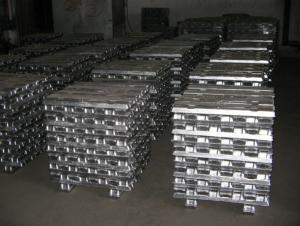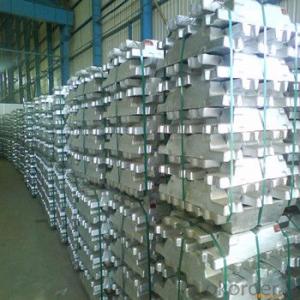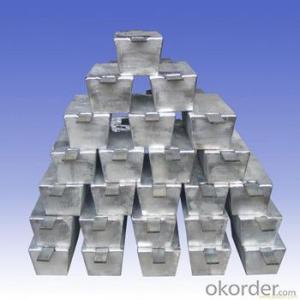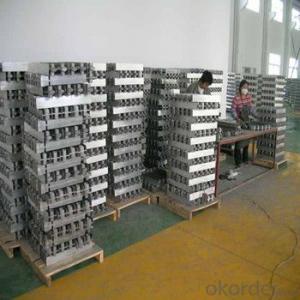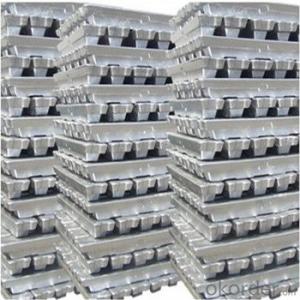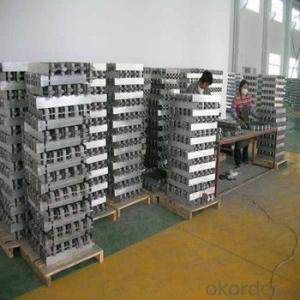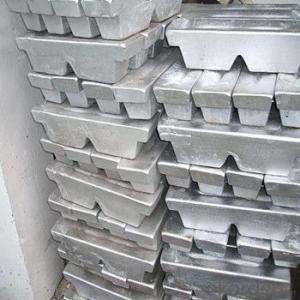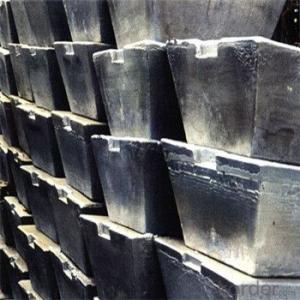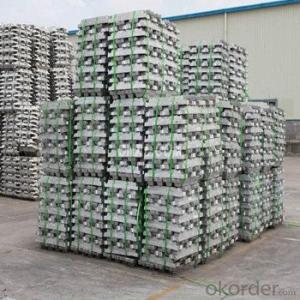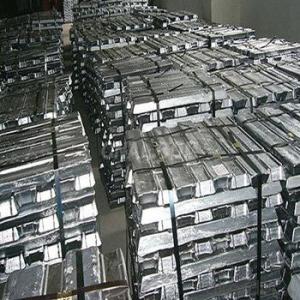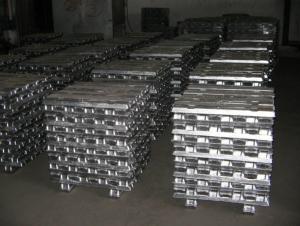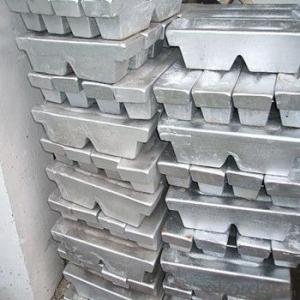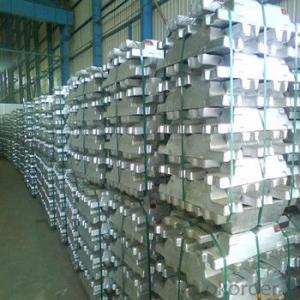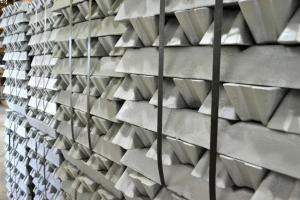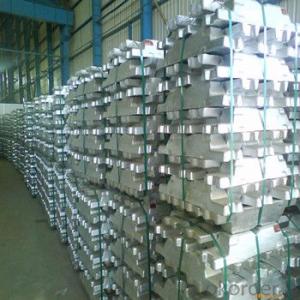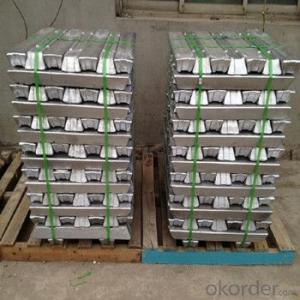Aluminum Ingot With Wholesale Price From Mills
- Loading Port:
- China main port
- Payment Terms:
- TT OR LC
- Min Order Qty:
- 100000 m.t.
- Supply Capability:
- 100000 m.t./month
OKorder Service Pledge
OKorder Financial Service
You Might Also Like
Pure Aluminum Ingot Used for Industry
1.Structure of Aluminum Ingot Description
A material that has been cast into a shape in order to be transported and processed easier than in an unprocessed form. An ingot is typically rectangular in shape, which allows it to be stacked. Ingots are most commonly associated with metals, with ingots of gold held in the vaults of banks and brokerages being popular images.
2.Main Features of the Aluminum Ingot
•High Purity
•High strength
•Fast melting
•Best price
•Good after-service
3. Aluminum Ingot Images
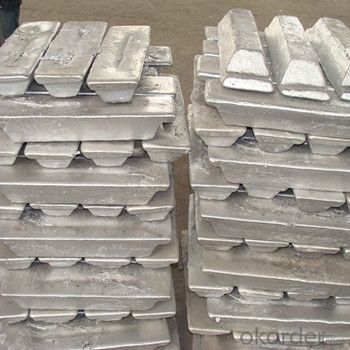
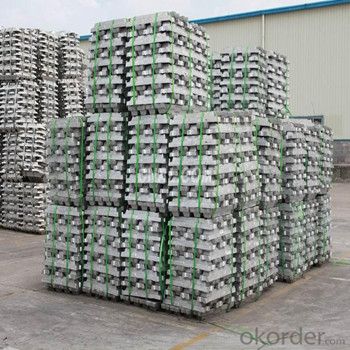
4. Aluminum Ingot Specification
Item | Aluminum Ingot 99.7,Aluminum bar/aluminum rod,Aluminum billet,Aluminum bar,6063 aluminium bar, Aluminium products | |
Standard | GB/T3191-1998,ASTM B221M-05A,JIS H4040-2006,etc | |
Material | 1A99,1A97,1A95,1A93,1A90,1A85,1A80,1A80A,1070,1070A,1370,A1060,1050,1050A,1A50, 1350,1145,1350,1A30,1160,1200,1235 2A01,2A02,2A04,2A06,2A10,2A11,2B11,2A12,2A13,2A14,2A16,2B16,2A17,2A20,2A21,2A25, 2A49,2A50,2A70,2A80 3A21,3003,3103,3004,3005,3105 4A03,4A11,4A13,4A17,4004,4032,4043,4043A,4047,4047A 5454,5154A,5754, 5056,5356,5456,5082,5182,5086 6A02,6B02,6A51,6101A,6005,6005A,6351,6060,6061,6063,6063A,6070,6181,6082 7A01,7A03,7A04,7A05,7A09,7A10,7A15,7A19,7A31,7A33,7A52,7003,7005,7020,7022,7050, 7075,7475 | |
| Size | Diameter | 1/2''-100'' |
Length | 1-12m,or as required. | |
Surface | Bright,polished,hair line,brush,embossed,etching,color coated,painted,etc | |
| Delivery time | 1.The products in stock will delivery immediately received the payment. 2.According to the order quantity,prompt delivery. | |
Export to | Ireland,Singapore,Indonesia,Ukraine,Spain,Canada,USA,Brazil,Thailand,Korea,Iran,India,Egypt, Kuwait,Oman,Viet Nam,South Africa,Dubai,Russia, England,Holland,etc | |
Package | Standard export package,such as wooden box or as required. | |
Application | Widely used in all walks of life,such as cars,ships,aerospace,aviation,electronics,agriculture, mechanical and electrical,home. | |
Container size | 20ft GP:5898mm(Length)x2352mm(Width)x2393mm(High) 24-26CBM 40ft GP:12032mm(Length)x2352mm(Width)x2393mm(High) 54CBM 40ft HC:12032mm(Length)x2352mm(Width)x2698mm(High) 68CBM | |
5.FAQ of Aluminum Ingot
We have organized several common questions for our clients,may help you sincerely:
①How about your company?
A world class manufacturer & supplier of castings forging in carbon steel and alloy steel,is one of the large-scale professional investment casting production bases in China,consisting of both casting foundry forging and machining factory. Annually more than 8000 tons Precision casting and forging parts are exported to markets in Europe,America and Japan. OEM casting and forging service available according to customer’s requirements.
②How to guarantee the quality of the products?
We have established the international advanced quality management system,every link from raw material to final product we have strict quality test;We resolutely put an end to unqualified products flowing into the market. At the same time, we will provide necessary follow-up service assurance.
③How long can we receive the product after purchase?
In the purchase of product within three working days, We will arrange the factory delivery as soon as possible. The pecific time of receiving is related to the state and position of customers.Commonly 7 to 10 working days can be served.
- Q: What is the tensile strength of aluminum ingots?
- The tensile strength of aluminum ingots can vary depending on the specific alloy and manufacturing process used, but on average, it ranges between 20,000 and 60,000 pounds per square inch (psi).
- Q: How are aluminum ingots protected from corrosion?
- There are several methods available to protect aluminum ingots from corrosion. One of these is applying a protective coating or film to the surface of the ingots. This coating acts as a barrier, preventing direct contact between the aluminum and the environment and reducing the risk of corrosion. Coatings can include paint, lacquer, or specialized epoxy coatings. Another method is anodization, which involves an electrochemical process that creates a thick oxide layer on the ingots' surface. This oxide layer not only improves the appearance of the ingots but also provides a strong defense against corrosion. Anodization can be done using different techniques, such as sulfuric acid anodizing or chromic acid anodizing, depending on the desired level of protection. In addition, proper storage and handling practices are crucial in protecting aluminum ingots from corrosion. It is important to store the ingots in a dry and well-ventilated area to minimize moisture exposure. They should also be stacked and stored in a way that allows air circulation to prevent the formation of stagnant water or condensation. Regular inspections and maintenance are necessary to detect any signs of corrosion early on and take appropriate action to address it. To sum up, protecting aluminum ingots from corrosion requires a combination of protective coatings, anodization, and proper storage and handling practices. By implementing these measures, the durability and quality of aluminum ingots can be preserved, ensuring their suitability for various applications.
- Q: Can aluminum ingots be customized for specific applications?
- Yes, aluminum ingots can be customized for specific applications. Aluminum is a versatile material that can be alloyed with other elements to enhance its properties such as strength, corrosion resistance, and thermal conductivity. By carefully selecting the alloy composition and processing techniques, aluminum ingots can be tailored to meet the specific requirements of various applications ranging from automotive parts to aerospace components.
- Q: How much is a ton of aluminium ingots now?
- Spot surface: yesterday in the impact of the disk, the spot market climate has picked up; market bullish mentality, is expected to rise in aluminum prices today.
- Q: Analysis of die casting aluminium ingot
- Non standard ingot ingredients as follows. (general non-standard zinc die-casting aluminum ingot will exceed the standard in 2-3, such as: Japan) ADC12Z (zinc below 3) silicon slightly low, other elements are close to ADC12. (GB aluminum standard available, here no longer).
- Q: What are the advantages of using aluminum ingots in the production of packaging materials?
- There are several advantages of using aluminum ingots in the production of packaging materials. Firstly, aluminum is lightweight yet sturdy, making it an ideal choice for packaging materials as it ensures easy handling and transportation while providing protection to the contents inside. Secondly, aluminum is a highly malleable metal, allowing for flexibility in design and customization of packaging shapes and sizes according to specific requirements. Additionally, aluminum is corrosion-resistant, ensuring the durability and longevity of packaging materials, even in harsh environments. Furthermore, aluminum has excellent barrier properties, effectively protecting the packaged goods from moisture, oxygen, and other external factors that could potentially degrade the product quality. Lastly, aluminum is a sustainable material, as it is easily recyclable without losing its properties, contributing to the circular economy and reducing the environmental impact of packaging waste.
- Q: What are the different methods for machining aluminum ingots?
- There are several different methods for machining aluminum ingots, depending on the desired shape, size, and accuracy required for the final product. Some of the common methods include: 1. Milling: This is a process where a rotating cutter removes material from the ingot to create the desired shape. It is suitable for creating flat surfaces, slots, and holes. 2. Turning: In this method, the ingot is rotated while a cutting tool removes material to create cylindrical shapes. Turning can be used to create shafts, rods, and other cylindrical components. 3. Drilling: Drilling is a process where a rotating tool with cutting edges is used to create holes in the aluminum ingot. It is commonly used to create holes of various sizes and depths. 4. Grinding: Grinding involves using abrasive wheels or belts to remove material from the ingot's surface, creating a smooth and precise finish. It is often used to achieve tight tolerances and precise dimensions. 5. Sawing: Sawing is a process where a saw blade cuts through the aluminum ingot to create desired shapes or separate the ingot into smaller pieces. It is commonly used for cutting aluminum ingots into bars or smaller billets. 6. Waterjet cutting: Waterjet cutting uses a high-pressure stream of water mixed with abrasive particles to cut through the aluminum ingot. This method can create complex shapes and does not generate heat, making it suitable for cutting delicate or heat-sensitive materials. 7. Electrical discharge machining (EDM): EDM is a process that uses electrical sparks to remove metal from the aluminum ingot. This method is often used for intricate or detailed shapes that are difficult to achieve with conventional machining methods. It is important to select the appropriate machining method based on the specific requirements of the aluminum ingot and the desired final product. Factors such as the ingot's size, shape complexity, tolerance requirements, and material characteristics will influence the choice of machining method.
- Q: It can be dissolved aluminum cans, aluminum ingots, need what equipment?
- A lot of cans are iron, not much aluminum.
- Q: What are the challenges in sourcing sustainable aluminum ingots?
- Sourcing sustainable aluminum ingots presents various challenges. One of the primary obstacles involves ensuring that the aluminum is produced in an environmentally-conscious manner. This entails minimizing energy consumption and carbon emissions linked to the production process. Many aluminum smelters still rely on fossil fuels for energy, which has a significant detrimental effect on the environment. Another challenge lies in verifying the origin of the aluminum. It is crucial to guarantee that the raw materials used in ingot production are ethically sourced and not associated with deforestation, human rights abuses, or conflict zones. This necessitates a robust and transparent supply chain capable of tracing the aluminum back to its source. Additionally, the issue of waste and recycling needs to be addressed. Aluminum is highly recyclable, but significant amounts of aluminum waste still end up in landfills. Encouraging and incentivizing aluminum recycling is vital to mitigate the environmental impact of its production. Furthermore, the availability of sustainable aluminum ingots can be limited. Not all aluminum producers have adopted sustainable practices, resulting in a lack of supply in certain regions or industries. This poses a consistent challenge for businesses seeking to source sustainable aluminum ingots. Overall, addressing these challenges is essential to promote an environmentally-friendly and responsible aluminum industry. By striving for sustainable sourcing practices, we can minimize the environmental impact of aluminum production and contribute to a more sustainable future.
- Q: Who knows but also can do aluminium ingots what products?
- Made of aluminum ingot is only the intermediate process, convenient transportation, adjustment of ingredients, etc.Also, a lot of scrap metal recycling scrap. Mainly re refining recycled, made of sheet bar form ingots
Send your message to us
Aluminum Ingot With Wholesale Price From Mills
- Loading Port:
- China main port
- Payment Terms:
- TT OR LC
- Min Order Qty:
- 100000 m.t.
- Supply Capability:
- 100000 m.t./month
OKorder Service Pledge
OKorder Financial Service
Similar products
Hot products
Hot Searches
